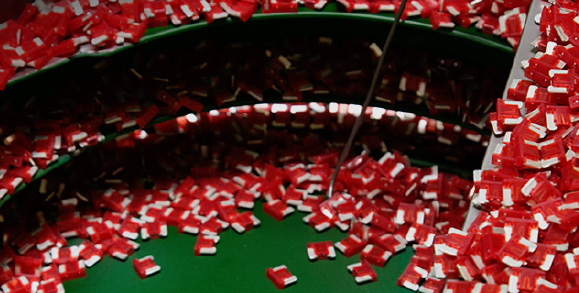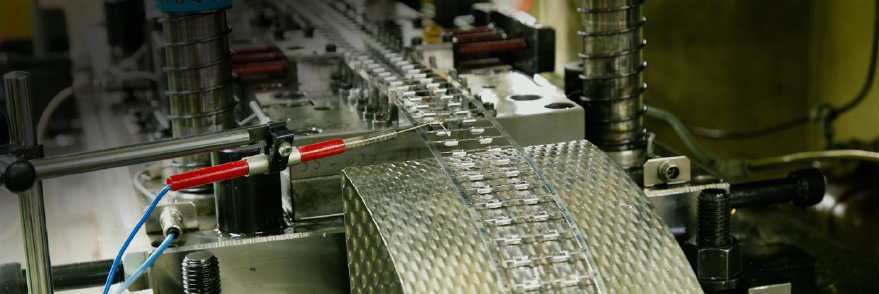PEC Future Roundtable
The next half-century.
What we can do in the dramatically changing automotive society.
Automotive societies around the world are plunging into a time of transition more far-reaching than any before. The issues at stake are a cutting-edge technology called CASE*1 and achieving the next-generation transport infrastructure, MaaS.*2 Right in the middle of this, PEC, which is expanding to sites around the world as global brand in fuses, must create further “New Frontiers.” Employees working in a range of fields at PEC got technology and shared their opinions on what sort of technology PEC needs to respond to this next-generation automotive society, what sort of businesses will be rolled out on the global market, and what sort of stance will be needed in order to grow further as a global company.
-
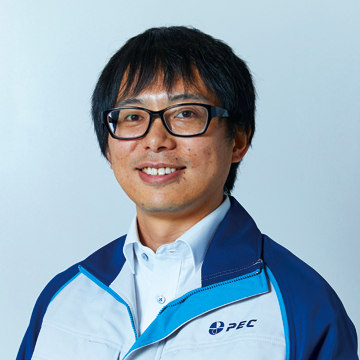 Yoshinori Kato, age 38Pacific Engineering Corporation
Yoshinori Kato, age 38Pacific Engineering Corporation
Production Engineering Department, Manufacturing Engineering Division -
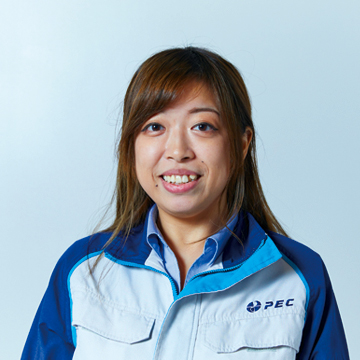 Sari Noguchi, age 27PEC of America Corporation
Sari Noguchi, age 27PEC of America Corporation
Detroit Technical Office
Engineering Group -
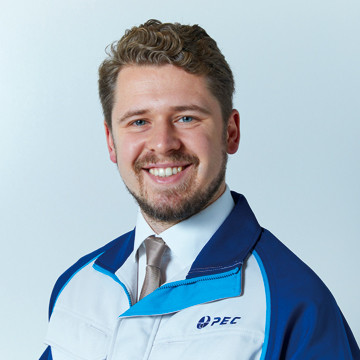 Johannes Bartels, age 31PEC (Europe) GmbH
Johannes Bartels, age 31PEC (Europe) GmbH
Sales -
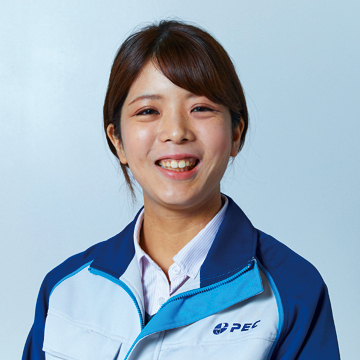 Akiko Takashima, age 26Pacific Engineering Corporation
Akiko Takashima, age 26Pacific Engineering Corporation
Sales Department, Sales Division -
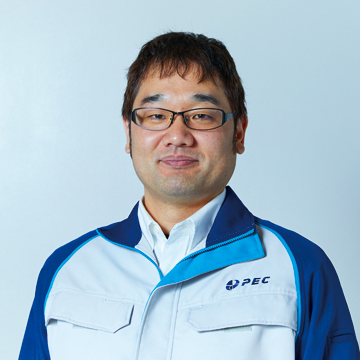 Yusuke Kondo, age 38Pacific Engineering Corporation
Yusuke Kondo, age 38Pacific Engineering Corporation
Research and Development Department, Research and Development Division
(1) How will our work change in the era of CASE?
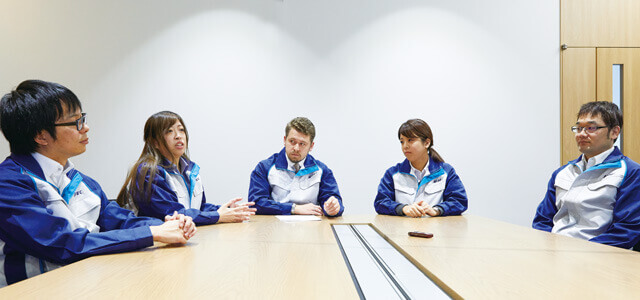
While there are some differences among countries, the era of CASE and MaaS has already begun.
We think PEC’s products will also change right from their concepts.
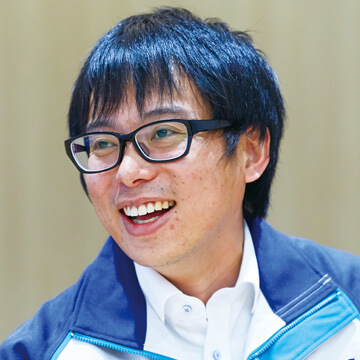
Kondo:I’m working on the development and design of next-generation fuse products that are totally unlike existing fuses. I've been at it for about three years. These next-generation fuses are a technology which has been getting a lot of inquiries from car manufacturers in Japan and the EU for a few years now.
As automobiles become more and more electrified, they use higher and higher voltages, and the risks in accidents also rise. This means we need even safer circuit protection devices. You might say they’re a product vital for the future mobility society.
Noguchi:So, is that the project about product development that goes beyond the current EV fuses?
Kondo:That's right. The area I’m in is one that’ll be absolutely required for creating the safer and more efficient cars that the world is aiming for, the so-called CASE and MaaS era, so this products goes beyond the boundaries of previous fuses.
Noguchi:I’m currently working at the Detroit Technical Office (PED), in the United States, and I get the feeling that in the American car industry, there honestly doesn’t seem to be a lot of demand for CASE. American Tier 1*3 manufacturers are now making a lot of cars for Asia, and the EV fuses we're developing here also often end up being manufactured in Asia. This means that it’ll be pretty difficult for EV fuses to make inroads into the American market. However, PEC’s large 12V Multi Slow Blow Fuse is getting a large share thanks to its high reputation.
Hybrid cars in the States have a lot of cameras and sensors, and their batteries are getting bigger, which means they need circuit protection. At the moment, the large fuses I helped design are highly regarded in America. In terms of CASE, we're at the stage where development studies for the electrification of trucks are now starting to be carried out seriously.
Kondo:Are electric vehicles still slow to take off in the United States?
Noguchi: Indeed. Which is precisely why we need to make people think of PEC products as being good quality. A lot of parts manufacturers from around the world are entering America these days. So what we can do here is continue to supply good quality products constantly as a highly trusted specialist manufacturer. And to make sure people know we can. Mr. Bartels, what’s happening in the EU market?
Bartels:I've been working as an Assistant Sales Manager at PEC Germany (PEE) since 2015, and the EU market has more interest in CASE and MaaS than any other region in the world, partly due to the recent fraud issues with Tier 1 manufacturers.
PEC’s EV fuses are very trusted, and are used by a lot of manufacturers. We get a lot of inquiries from Tier 1 companies so we’re in a very good position. However, technology manufacturers in Germany and other places are already seriously working on the development of these next-generation fuses, so PEC might be a little late to the game.
This is your field, Mr. Kondo, so I hope you’ll do your best.
Kondo:Now I suddenly seem to have some motivation. [Laughs]
In any case, the concepts of CASE and MaaS aren't future ones, but a reality that has already begun.
PEC's EV fuses are trusted, but the world wants to see even newer devices. I believe our engineers are being tasked with these, including the theme “what shape should fuses take?”.
Takashima:As Mr. Kondo notes, once the era of CASE and MaaS arrives, the concept of what a fuse is will change, right? However, we in sales often talk about cars five, ten years down the line when we visit manufacturers.
The main sort is, of course, EV fuses, but at the same time, the need for low-voltage fuses like mini-fuses and blade fuses is certainly not small. Even as we head into the CASE and MaaS era, PEC’s foundations will be, more than anything, being our ability to answer the diverse needs of our customers.
PEC’s EV fuses are highly regarded today, but one major reason for that is, I feel, the fact that we started automated production of large EV fuses before anywhere else.
PEC was ready to mass-produce EV fuses when the electrification wave hit. That's a huge strength for PEC, and shows how impressive the production technologies you're involved with, Mr. Kato. [Laughs]
(2) What are the strengths of PEC in the next generation?
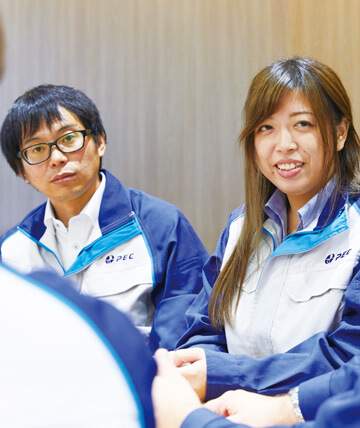
Product Development Capacity & Mass Production System
I want to broadcast these unique strengths of PEC to the global market even more
Kato:Thank you! My job is mainly designing production facilities and lines to manufacture newly released products, but at the same time, I also work on improving yields of current products and maintaining stable production lines.
PEC has a diverse lineup of fuses, so it is very important to have efficient production lines for all of them.
Takashima:PEC's products are constantly being improved in response to customer demands, and I imagine automating production lines to cope with this would be very hard.
At the moment, we're at nearly 100% automated production for low-voltage fuses, right?
Kato:Right. 100% automated production. And we're at about 40% automated production for EV fuses as well.
PEC is working on automating production in the same way as other lines, building on this track record. In particular, the aim is for almost 100% automated production lines for the new products that will be developed in the future.
Takashima:This strength of PEC in production systems distinguishes us from our competition, but does the world market realize it?
Bartels:No, I don't think they do properly. We need to create more awareness globally that the trust in PEC products comes from its production system.
As cars become electrified, they’re going to inevitably end up costing more. But if they cost more, customers won't want to buy them.
So, to keep the prices of cars down, we need to keep the costs of the various parts down.
PEC products, known for their quality, can be provided cheaply thank to our automated production, which is a big point in our favor.
We enjoy trust in our current products, so people are definitely going to be looking to us in the future.
Takashima:PEC's production system allows us to stably supply the products our customers want faster and cheaper than our competitors, providing better quality and prices, which is a huge advantage. So this strength means we in Sales can give presentations to our customers with confidence.
It’s not just about making production lines more efficient: PEC needs to always consider the possibilities of new products to take on the EV fuses of our competitors.
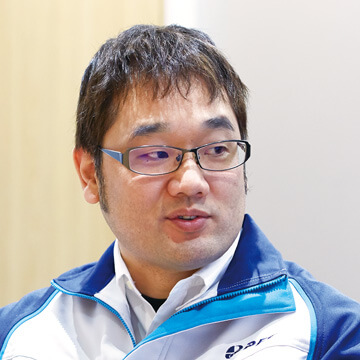
Kato:As a pathway to vehicle electrification, I’m very glad we have been able to establish the automated production of EV fuses.
This initiative was actually started the year before last, but now we're finally able to start proper operation [laughs]. Thanks to that, what required several workers to do by hand is now automated, and we're able to get to the final product testing using machines, so full automation of all production lines has made things more compact and eliminated a lot of waste.
Obviously, we can't use the same production line design for all products, but the question is, how can we assemble the products our customers want efficiently?
What systems in the operating production lines can be utilized in the subsequent lines?
We study the specifications needed for each separate product, using a process of trial and error until we perfect it.
(3) How will PEC’s manufacturing change in the next ten years?
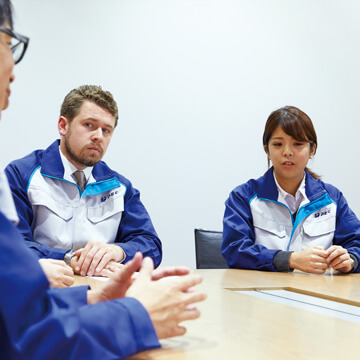
Manufacturers around the world are looking to PEC not just for our fuses but as a specialist in circuit protection.
Takashima:However, as we enter the CASE era, there's no doubt that we’ll see a lot more sensors and control functions required to ensure vehicle safety in the future, so naturally what's required of fuses will also change.
So if the shape of fuses changes, then their production system will also be different to what it is now.
The part where we’ve previously felt that “fuses should be this way” may also change to something like “is the material we're using here really appropriate?” as we review our materials to keep costs down or increase safety.
Kondo:In fact, we’ve already started this sort of initiative at PEC.
For example, from the questions “can we improve the designs of PEC’s current products? Can we make them cheaper?” in which we consider the issue of new materials for products, to the question of “is this the best way to make this product?” which is about the production line issues that Mr. Kato is working on, we're considering quite a number of things.
Looking a bit further into the future, in the area of “what is going to happen to systems in future cars?” we have the perspectives of “what are fuses going to be combined with?” and “fuses will be replaced with something completely different.”
In that sense, I believe that a time is coming when we at PEC must broaden our perspectives as specialists in the field of circuit protection to include what future fuses will be like.
Takashima:You’re talking about not just EV fuses, but PEC’s future products, right?
Kondo:For PEC, talking about product development is important, but we also have the issues of production sites in the future, don't we? We currently have production sites in Japan, Thailand, and Mexico, but are these the optimal places in consideration of the future global market? Looking at it from the perspective of distribution, a key theme we need to look at is the construction of supply networks that match market needs better in the EU, the USA, and Asia.
Bartels:Indeed. Being able to be more efficient would be a good idea in terms of the distribution of PEC products.
We have an R&D site in the EU, but no production site. But EU car manufacturers have a lot of interest in PEC's highly reliable products, so there are definitely business chances available.
Which means that we want a system that’ll allow us to manufacture in Europe as well in the future. In particular, the next-generation fuses Mr. Kondo is working on won't be able to be imported easily due to strict regulations, so it would be better if they could be manufactured locally in future. I urge you to consider this. [Laughs]
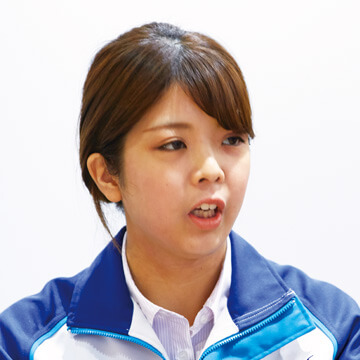
Takashima:Indeed. For example, it'd be better if, instead of making EV fuses for the American market in Japan and shipping them over, we could make everything for the American market in Mexico.
Noguchi:At the PED office in America where I’m based, I work on product design, but we haven't been able to commercialize anything, so when an American manufacturer asks us if we can make something, I immediately check with Ms. Takashima or Mr. Kondo in Japan. My job is to get a handle on changes in the American market as soon as possible, and I believe it's important to get information about what sort of products American customers want, or what their future needs will be, to our Head Office in Japan speedily.
Our supervisors in Japan can't be constantly flying to the States, so I think we should construct a production and distribution system led by PED members that minimizes little time loss by liaising with the Mexican plant.
More than anything, the most important theme is to promote PEC’s fuses and expand needs in the North American market.
Bartels:There's certainly differences in markets, but as electrification and the CASE concept are only going to increase in America over the next few years, I think PEC products are definitely going to have a bigger presence.
(4) What is the corporate power of PEC as it creates “New Frontiers” for the future?
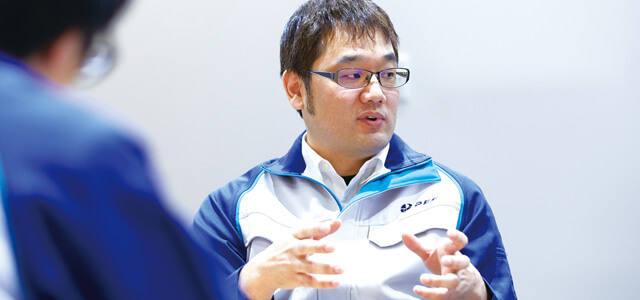
PEC’s diversity, understanding each other beyond national or departmental borders, forms a major strength.
Now is the time to become One Team that will change the world.
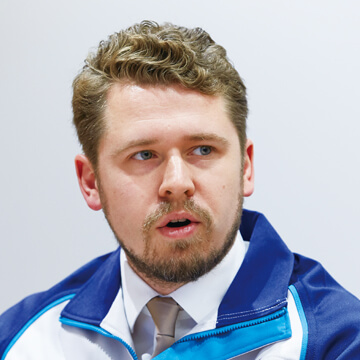
Takashima:There was a place where these differences in world markets could be understood by the different PEC sites and all of PEC could think together about where we should be heading from here.
That was the Global Sales Meeting held in Germany in November 2019. Mr. Bartels, you took part in this. What was it like?
Bartels:At the Global Sales Meeting, we clarified market issues at sites in each country and formed action plans (targets).
Managing the monthly targets for each site, we shared with each site how we in Europe were moving ahead with the plan. Up until now, PEE and PED have not had any connections in general, due in part to the differences in market environments.
Naturally, Japan and PES (China), Japan and PEE, and Japan and PED all have links, with Japan as the core, but there are few links between sites, and PEC Global has never come together in one place.
But by holding meetings like this one, where each site attends, means that for example if America has a problem or issue with something, then Europe can say, “we’ll help you with it.” It’s not rugby, but Global PEC really is One Team! [Laughs] The world's automotive society needs will be rapidly changing from here on, so it's important that PEC makes its diversity one of its strengths.
Noguchi:We at PED have been in quite close communication with PEE as well. In terms of technology as well, for example, at the World Wide Technology Conference held in Japan in December 2019, we announced PED’s strategy roadmap regarding future prospects based on the needs of the North American market.
This was the first such initiative for Global PEC.
Kondo:What I sensed at this conference was, for example, recently, overseas sales people have brought a range of information, but even though more people are asking “can you make us this?” but there wasn't enough discussion at Japanese technology sites along the lines of “why do you need this sort of thing?” or “what is the purpose for developing or improving this thing?”
There were aspects where we were not able to share an awareness of the essential, core part—what the development level actually is—with regards to what is required of us.
That's a big issue for those of us in the technology field.
Bartels:So that's a failure of letting people know that PEC is going to make this sort of product in future, or we're aiming for this sort of advanced technology, in the fields of product development and technology?
Kondo:Right. We’re getting lots of inquiries from overseas these days, but even when, for example, a PEC sales representative asks someone in R&D if they can provide some materials related to a given product so the reps can go to these markets and sell them, they often come back to us with “Sorry, we're unable to develop in time, so we don’t have any at this moment.”
Kato:Indeed. In that sense, too, the World Wide Technology Conference was a great opportunity for us as well. It really is important for employees in many fields to learn about global trends and share their understanding.
Takashima:Technical development and product development are just so broad, from improvements to the detailed specs for current products to larger themes of dealing with new needs, each of which takes time.
But what I want for PEC is a message that lets people know what products and technologies are going to be needed in future and what we should aim for next.
Kondo:In that sense, too, it's important to have a wide knowledge of the issues and needs from the United States and Europe.
I think we have to be actively aware of and understand information and targets regarding a range of themes and overseas sites, and actively work ourselves to communicate.
Kato:We in production technology haven't really had a lot of interact with overseas [Laughs].
In our case, our contact with overseas is only when solving issues with production facilities overseas or developing production facilities for products we’re now producing overseas.
The focus has been on how efficiently we can make that product, and so far, we've been happy with that. Frankly, we don’t have much interest in the issue of what sort of products PEC is going to want to make in the future, and don't really fully get new product trends.
However, as long as we continue to manufacture at PEC, I think we need to broaden our knowledge of trends like CASE, actively taking in detailed information, while contacting other fields.
Takashima:But lately, we get a lot of inquiries from the production technology people along the lines of “Is production of this product going to increase in future?”.
In Sales, we get a lot of questions like “What sort of facilities should we have if production quantities are going to increase three years from now?”.
We in Sales do, of course, work with forecasts of three to five years ahead, times for which we don't have any orders, so I think we do have a responsibility to let the production technology people know what the trends are.
We can't go around saying “This product probably won't be all that big” and then end up being unable to ramp up production when needs suddenly grow quickly. [Laughs]
Kato:This World Wide Technology Conference was our first such initiative, people--including me--who hadn't know PEC people in other departments that well were for the first time able to sense that PEC’s connected with the world, the industry, in these ways, or how great it is that all these different departments are working towards the same goal.
(5) What sort of corporate environment does PEC have that allows each employee to maximize their abilities and individuality?
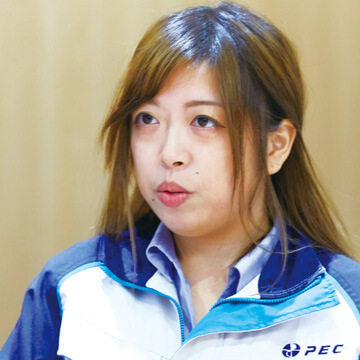
Whether in America, Europe, or Japan, we can work with a mutual understanding and the same values.
Because PEC is a global company that we can be proud of to the world.
Bartels:Business culture and customs are different in each country. Understanding that, it's important to continue properly showing that PEC is a company that protects the reliability of its products, displaying our intent without wavering.
I’m German, but I have the same values and goals as others even if I have minor issues with a few things, so I get satisfaction from my job.
Noguchi:I grew up in the States, went to school there, and joined PEC, a Japan-based company.
Now I’m working in Detroit, but I always think PEC is a really easy place to work, a company that's really good to those who work here. I was quite surprised when visited PEC PARK, the new PEC Head Office and plant, when I came over to attend the World Wide Technology Conference. [Laughs] You see, at PED in the States where I work, we only have a dozen or so people in a small office, and I come here and the office is so new and clean, has all these facilities, and more than anything, you can see the plant right there, so it's easy to communicate with people working on production.
It made me think, “wow, it’s really okay for me to work at a place like this?”
Takashima:I’ve only been with PEC for three years, so I don't have that much experience with the work, but what I’ve felt is that even younger employees like me can actively make comments, and there's a lot of superiors and senior employees nearby who’ll genuinely listen to my opinions. We have a free address office, so we can sit wherever we like each day.
This makes it easy to talk to the people around us, and we can work in really close proximity to senior employees and colleagues. I’m grateful to be able to grow in an environment like this.
Kondo:PEC employees work harmoniously, accepting each other. In my R&D department too, everyone feels the sense that they're tackling something new, and we're all forward-looking.
Bartels:This is my third visit to PEC PARK, but it really is a wonderful office environment. In the Head Office in Japan, there are lots of different departmental specialists, like Mr. Kondo, so I learn a lot from talking with these people.
There's meaning in discussing all sorts of things with Ms. Noguchi from PED or Ms. Takashima, who helps bridge the gap in Japan, and my time here has not been wasted at all.
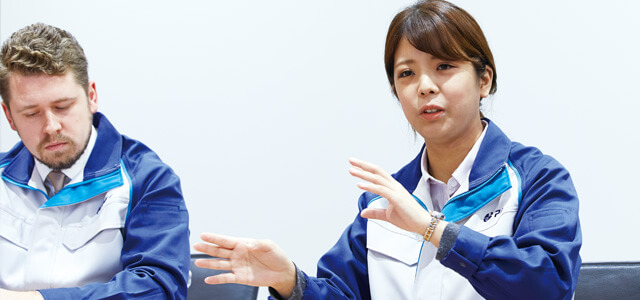
Takashima:I also get the sense that PEC is definitely changing. We have a new Head Office and factory in Japan, and I am sure everyone at PEC, including our global employees, feels the same way.
Now, as automotive societies around the world are changing, PEC has its unique product development and production technologies, and I believe we can become a global company that we can be even more proud of to the world.
*1. CASE stands for Connected, Autonomous [automated driving], Shared & Services [car-sharing], Electric [electrification]. It is a key word that points the way to where automotive societies are headed.
*2. MaaS stands for Mobility as a Service. It refers to a system that allows buses, trains, taxis and other public transport to be connected seamlessly using IT to let people use them more efficiently and conveniently.
*3. In the automobile industry, Tier 1 refers to manufacturers that supply parts directly to completed vehicle manufacturers.


